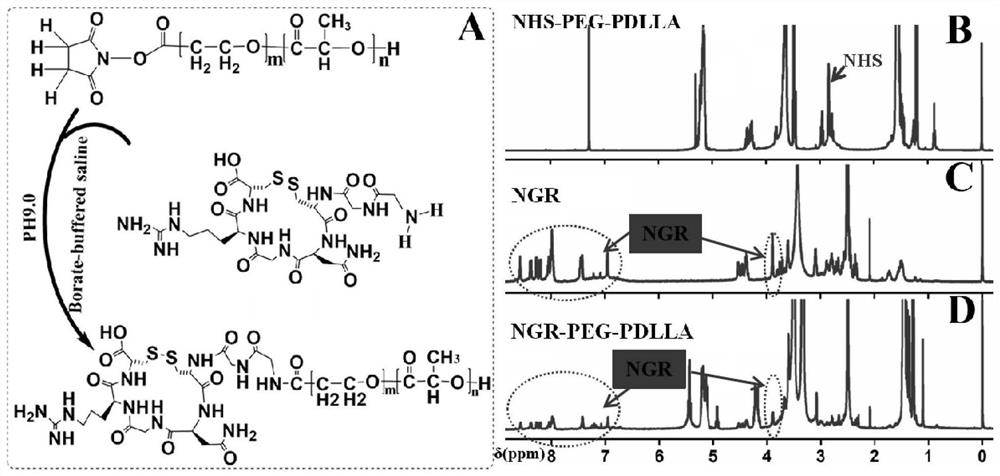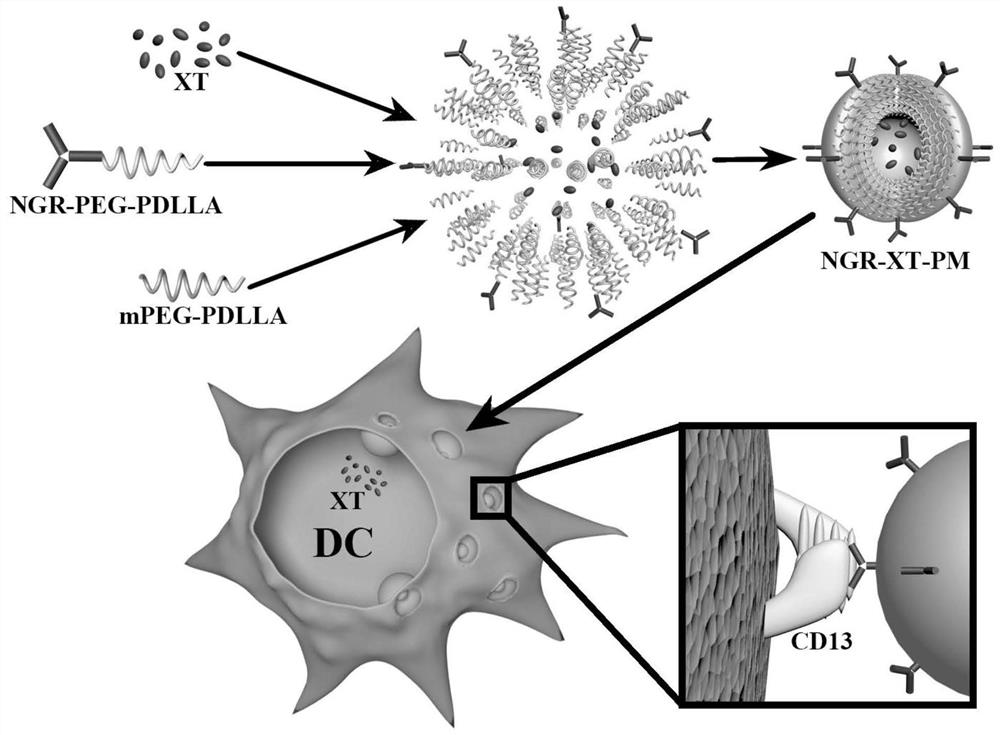A kind of Xanthiting nano-micelle targeting dendritic cells and its preparation method and application
A technology of nano-micelle and dendritic cells, which is applied in the direction of non-active ingredient medical preparations, medical preparations containing active ingredients, and pharmaceutical formulations to reduce non-specific phagocytosis, enhance the concentration of action, and facilitate the collection and concentration poly effect
- Summary
- Abstract
- Description
- Claims
- Application Information
AI Technical Summary
Problems solved by technology
Method used
Image
Examples
Embodiment 1
[0045] (1) NGR-modified targeted polymer synthesis
[0046] Its preparation method includes: dissolving NHS-PEG-PDLLA and NGR in borate buffer (Borate-buffered saline, PH = 9.0) at a molar ratio of 2:1, reacting at room temperature and stirring for 12 h, then dialyzing with distilled water ( MWCO3500da) was purified and freeze-dried to obtain NGR-PEG-PDLLA. The resulting product is used 1 H NMR for structural identification, the results are as follows figure 1 .
[0047]Results and analysis: Figure A is the synthesis route of the NGR-modified nanomaterial NGR-PEG-PDLLA. Figure B, Figure C and Figure D are the NMR spectra of the starting material NHS-PEG-PDLLA, NGR and the product NGR-PEG-PDLLA in the synthesis scheme, in which the ellipse represents the characteristic peak of NGR, and the reaction product spectrum shows the characteristic peak on NHS (δ 2.65 ppm) disappeared, while the characteristic peak of NGR appeared, indicating that NGR was successfully connected to t...
preparation example 1
[0050] Preparation Example 1: Weigh 36 mg carrier material (35.1 mg mPEG 2000 -PDLLA 2000 and 0.9 mg NGR-PEG 2000 -PDLLA 2000 ) and 2 mg Xanthiting were placed in a round bottom flask, 4 mL of absolute ethanol was added, and the carrier material and drug were fully dissolved by ultrasonication. The solution was placed in a rotary evaporator at 60 °C for 30 min to evaporate the organic solvent completely to obtain a dry and transparent mixed film matrix. Then 10 mL of water for injection preheated at 60°C was added, hydrated to form micelles under stirring conditions, and then passed through a 0.22 μm sterile filter membrane for fine filtration to sterilize, and the filtrate was freeze-dried to obtain a sample. The result is as figure 2 shown.
[0051] Preparation method of fluorescence-loaded targeting polymer micelles (NGR-DiI-PM):
preparation example 2
[0052] Preparation example 2: Weigh 36 mg carrier material (35.1 mg mPEG 2000 -PDLLA 2000 and 0.9 mg NGR-PEG 2000 -PDLLA 2000 ) and 2 mg of fluorescent dye DiI were placed in a round bottom flask, 4 mL of absolute ethanol was added, and the carrier material and drug were fully dissolved by ultrasonication. The solution was placed in a rotary evaporator at 60 °C for 30 min to evaporate the organic solvent completely to obtain a dry and transparent mixed film matrix. Then 10 mL of water for injection preheated at 60°C was added, hydrated to form micelles under stirring conditions, and then passed through a 0.22 μm sterile filter membrane for fine filtration to sterilize, and the filtrate was freeze-dried to obtain a sample.
[0053] Preparation method of blank targeting polymer micelles:
PUM
| Property | Measurement | Unit |
|---|---|---|
| particle size | aaaaa | aaaaa |
Abstract
Description
Claims
Application Information
 Login to View More
Login to View More - R&D
- Intellectual Property
- Life Sciences
- Materials
- Tech Scout
- Unparalleled Data Quality
- Higher Quality Content
- 60% Fewer Hallucinations
Browse by: Latest US Patents, China's latest patents, Technical Efficacy Thesaurus, Application Domain, Technology Topic, Popular Technical Reports.
© 2025 PatSnap. All rights reserved.Legal|Privacy policy|Modern Slavery Act Transparency Statement|Sitemap|About US| Contact US: help@patsnap.com



